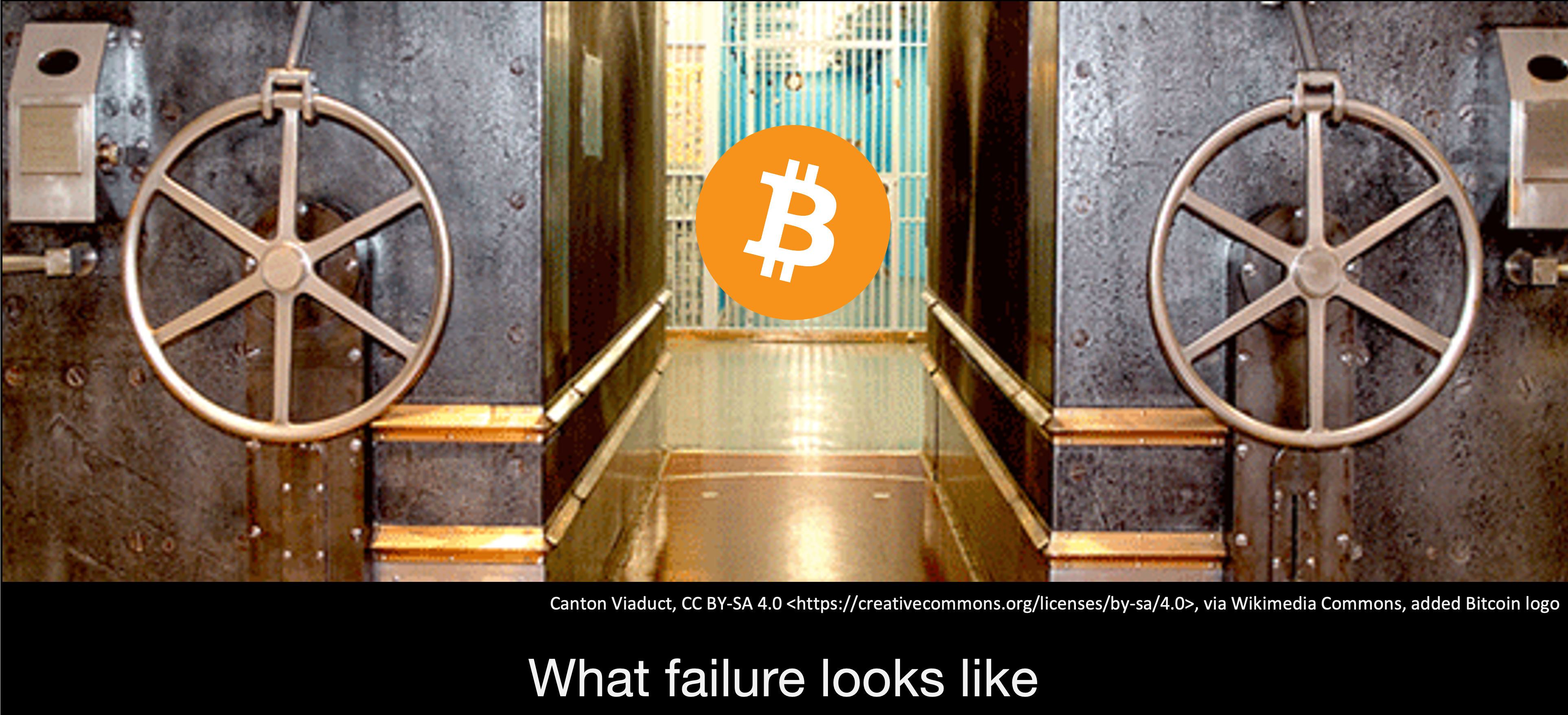Gold vaults
A year ago I toured the gold vault beneath the New York Fed. You might recall it from the classic 1995 movie Die Hard with a Vengeance, but in case you aren’t familiar: It’s the world’s largest depository of monetary gold, storing over 6,000 tons 80 feet below Manhattan and protected by airtight vaults and its own police force.
The first thing I thought when I was down there was wow, gold is very shiny. The second was wow, gold bars are surprisingly heavy, in part because of its density (bars are 28 pounds). They make you wear metal shoe covers to hold one in case you drop it on your foot. But the third thing I thought is “THIS is what the global monetary system rests on? This is just so antiquated.”
The New York Fed gold vault has some surprising similarities to Bitcoin:
- Pseudonymity: Each country’s holdings of gold are held in separate compartments that are identified by numbers, not names.
- Multisig: Each compartment is secured by a padlock, two combination locks and an auditor’s seal, each under the control of someone different so multiple people have to come together to open the compartment.
- Transaction fee model: Storage is free, but you pay to move gold bars in and out or between compartments. So HODLers free ride, which honestly makes me worry about its long-term sustainability.
- Vaults: It has multi-layered vault technology with timelocks! There is a 90 ton steel cylinder door, and once closed, it locks the vault till the next business day. And it’s an airtight and watertight seal.
But there’s a really important difference between the gold vault and Bitcoin. The gold vault is only available to governments, central banks, and official international institutions. Bitcoin is for anyone. We’re not just trying to digitize the gold vault. We’re trying to build something better.
Sometimes, though, we get distracted along the way. We get distracted by CEOs of $10 trillion+ asset managers name-dropping “Bitcoin” on CNBC or billionaires taking on debt to hoard coins or nation-state strategic reserves, we mistake all that for progress. But it’s not. Those things are second-order effects of progress. First-order progress is, and always was, USERS. Providing real value to real people. All the financialization, all the follow-on by institutions, it’s a side-effect, it’s not the real goal. Too often we forget that and chase the mirage.
Reflecting on MIT
Universities and academia are in a bit of a strange place right now. I am not really sure they’ll all survive (nor that they all should). But MIT is unique and well-positioned to weather the uncertainty facing higher education. The motto of MIT is “mens et manus”, or mind and hand. It signifies the fusion of the pursuit of academic knowledge with practical purpose. I feel grateful to have been trained here in graduate school, and I am so grateful for all the wonderful students, researchers, and staff I’ve gotten to work with at the Digital Currency Initiative. We all chose to be part of this quirky, earnest group trying to make a better financial system for everyone. Because of how special it is, I think MIT is in a unique place to contribute to this field, even more so than other schools.
Our field could use a little more mens et manus. Yes, the theory and protocol design are incredibly important. There is still so much to figure out and do. But the users are the real point. We have to solve real problems for real users.

If what we have in 50 years is the New York Fed Bitcoin vault, but users can’t easily and safely self-custody—we failed. If we build only for traders and whales and ignore those who need privacy, autonomy, and access—we failed. Also, quite frankly, it’s uninteresting: We’d just be replicating the existing structure of the financial system we’re trying to fix.
I don’t know if whatever we’re seeking is possible to achieve at scale, but I don’t know that it’s impossible either, and I’m not willing to give up yet.
The DCI has been steadily supporting senior Bitcoin developers for 10 years. The people who worked here have been quietly, but measurably, improving the Bitcoin network’s stability, scalability, and security. I hope the DCI is still at MIT in another 10 years—doing work that improves strong self-custody, privacy, and security, but also helps improve access to Bitcoin and other digital currencies as part of an open, permissionless financial system, a platform on which application developers can build services and applications that give users the tools they need to financially flourish.
If this mission resonates with you, reach out. We’re always looking for collaborators. And if you have the means, consider supporting our work—we raise all our own funding.